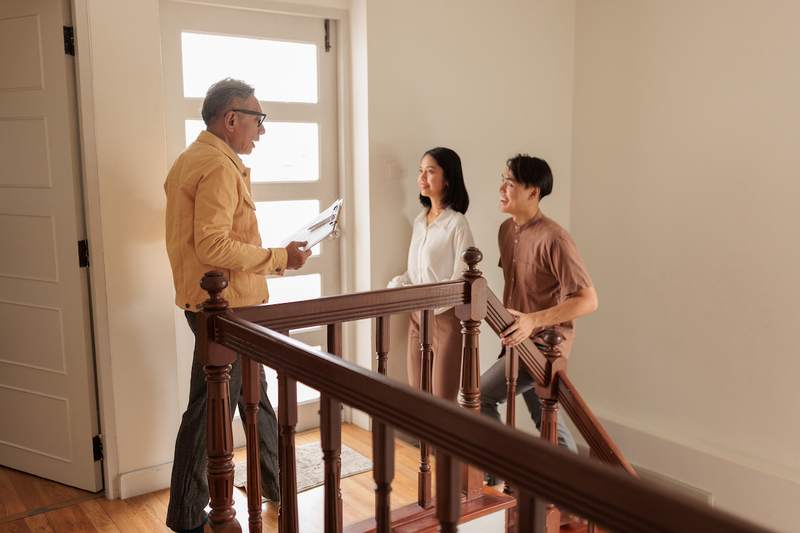Whether your parents are aging and you’re thinking of moving them close by, or you want a comfortable place for visitors to stay, a mother-in-law suite could be right for you.
So, what is a mother-in-law suite? It’s an addition to your home that serves as separate living quarters for guests, renters, or — as the name implies — your partner’s parents. It can be a separate dwelling or attached to your home, and usually has amenities similar to a small apartment.
If you’re considering adding a mother-in-law suite or buying a home that has one, here’s what you need to know:
- Mother-in-Law Suites Defined
- What Is an ADU?
- Types of Mother-in-Law Suites
- Mother-in-Law Suite Building Requirements
- Other Mother-in-Law Suite Requirements
- Advantages of a Mother-in-Law Suite
- Disadvantages of a Mother-in-Law Suite
- How To Build a Mother-in-Law Suite
- Cost of Building a Mother-in-Law Suite
- How To Finance a Mother-in-Law Suite
- FAQ: What Is a Mother-in-Law Suite?
- The Bottom Line on Mother-in-Law Suites
Mother-in-Law Suites Defined
There are many different room configurations that fall under the umbrella term “mother-in-law suite.” In general, it’s an addition to your home’s primary living space that includes spaces for cooking, sleeping, and living, as well as a bathroom.
More than just adding or renting out an extra bedroom, a mother-in-law suite provides privacy and separate living quarters in close proximity to the main home.
Other names for mother-in-law suites
Mother-in-law suites are sometimes known by other names, such as:
- Granny flat.
- Mother-in-law house.
- Mother-in-law apartment.
- Casita.
- Second unit.
- In-law unit.
- Backyard cottage.
- Garage apartment.
Uses for a mother-in-law suite
The name fits how most homeowners use a mother-in-law suite: as private but nearby living quarters for parents or grandparents. But that’s not the only purpose for which such an addition can be used.
“Some potential uses for a MIL suite include providing a separate living space for aging parents or adult children, renting out the space as a source of additional income, or using it as a home office or guest quarters,” says Humberto Marquez, a real estate agent with Awning, a real estate technology company and brokerage, based in Fort Worth, Texas.
Other common uses include:
- Short-term or long-term rental.
- Living space for an adult child with special needs.
- Private quarters for grown children living at home.
- Gym space.
- Man cave.
- Media room.
- Guest space.
- Craft room.
- Small-business headquarters.
- Live-in nanny or housekeeper quarters.
What Is an ADU?
In legal terms, mother-in-law suites are known as accessory dwelling units. Many government agencies offer financial and building assistance to homeowners looking to add a unit that qualifies as an ADU.
According to Fannie Mae, a mother-in-law suite can be classified as an ADU if it meets the following criteria:
ADU Requirements
| Size | Must be smaller than the primary home. |
| Access | Must have its own entrance. It also may have access to the primary home, but that cannot be an ADU’s only entry point. |
| Kitchen | Must include countertops, cabinets, a sink with running water, and a stove or stove hookups. Hot plates, microwaves, and toaster ovens do not qualify. |
| Quantity | A primary home may have only one ADU on the property. |
| Bathroom | Private toilet and bathing areas are required. |
Types of Mother-in-Law Suites
Mother-in-law suites come in a few common configurations and styles, most of which qualify as an ADU.
Detached units
Detached units are separate from the primary home, but still are on the same property. These often look like backyard cottages, casitas, cabins, or tiny homes.
Attached units
This type includes a basement suite, a room addition to the home, or a converted space such as a sunroom. Attached units often have direct access to the main home in addition to a private entrance.
Attached units may fall into the category of junior accessory dwelling units. Popular in California, JADUs must be 500 square feet or less, and may be built into the existing footprint and walls of a single-family home.
Interior suites
Interior suites are simply bedrooms within a home that have access to a private full bathroom and sometimes a private living space. They often are located separately from the home’s other bedrooms.
Garage conversion
If you have a garage you don’t use to store a vehicle, you can convert it into a mother-in-law suite as long as it meets local building requirements.
Mother-in-Law Suite Building Requirements
The requirements for adding a mother-in-law suite vary from place to place, and often relate to heating and cooling systems, smoke detectors, running water, and insulation.
To qualify as an ADU, a unit needs to have a separate entrance, as well as a kitchen, bathroom, and sleeping quarters.
Unit size
To qualify an ADU, mother-in-law suites generally must be smaller than the primary home.
Full kitchen
All mother-in-law suites must have a full, working kitchen to meet the legal definition of an ADU. According to Fannie Mae, this includes cabinets, countertops, a sink with running water, and a stove or stove hookups. You aren’t allowed to provide a microwave, toaster oven, or hot plate in lieu of a working stove.
Full bathroom
This includes at minimum a toilet, a shower or bathtub, and a sink with running water.
Private entrance
All ADUs must have a private entrance that is separate from that of the main house.
Zoning requirements
Depending on whether you want your mother-in-law suite to qualify as an ADU, there may be certain zoning requirements to meet. Most locations require the primary home to be on a residentially zoned lot with no covenants that would restrict an added dwelling — such as a homeowners association.
Other Mother-in-Law Suite Requirements
Mother-in-law suites usually are considered an extension of the primary property, and cannot be parceled out or sold as a separate residence.
They also cannot be sold, in most jurisdictions, as a partial interest in the property.
Utilities
Utilities for most units typically are on the same line and account as the primary home. If you plan to rent out your unit, you may want to factor a portion of the utility costs into the rent.
Some areas, however, will allow a separate utility connection for an ADU. This allows the occupant or tenant to pay for their own utility use.
HOAs
If you have an HOA, expect your mother-in-law suite to be governed by the same rules as the primary home. Be sure you understand your HOA rules, as they may restrict the ability to operate your unit as a short-term rental or impose parking requirements.
Advantages of a Mother-in-Law Suite
There are many advantages to having a house with a mother-in-law suite.
Convenience for family members or guests
A mother-in-law suite can act as a spare bedroom, according to Jon Sanborn, a real estate agent and co-founder of SD House Guys, a homebuying company in San Diego.
“The extra space may be used to house additional family members who visit or move in,” Sanborn says. “It also works well if you have frequent overnight guests.”
Privacy for family members or guests
A mother-in-law suite gives the occupant privacy. This is especially true with detached suites, says Marquez.
“Since these suites are typically separate from the main home, they provide a greater sense of privacy and independence,” he says.
Adds value to your home
Adding permitted living space to your property likely will boost its market value — and your home equity. However, that’s not the only source of value that a mother-in-law suite can bring.
“One of the main advantages of adding a MIL suite to a home is the potential for increased income through rental or Airbnb guests,” Marquez says.
Disadvantages of a Mother-in-Law Suite
Of course, there also are drawbacks to mother-in-law suites that you should consider.
Expensive to build and maintain
The bigger and more complex your property is, the more costly it’ll be to build and maintain a mother-in-law suite.
“Mother-in-law suites require regular upkeep,” Sanborn says. “This may include cleaning and maintenance on the building itself, as well as landscaping and other upkeep costs.”
Vacancies cost you money
If you plan to rent out your space, you may be able to offset your expenses and even turn a profit. However, it won’t generate income when it’s not being rented. Be sure to factor this possibility into your rental fees, and build a cushion to cover expenses during slow times.
Legal and tax liability
You may pay more for homeowners insurance after building a mother-in-law suite, and the value it adds to your home may increase its taxable value and your property tax bill.
How To Build a Mother-in-Law Suite
Want to build a mother-in-law suite on your property but aren’t sure where to start? Here are some tips.
Find a contractor
The right contractor can provide you with guidance and expertise in addition to their building skills. They also will be insured and bonded, and can pull any necessary permits.
Choose a plan
You can work with an architect or plan it out with your builder. You can find plans online or, depending on your area, may even be offered building plans and design guides through your city or county.
Prepare the site
You or your builder will need to prepare the site for construction. If you’re planning to convert a garage or basement, you may be able to cut costs by doing some demolition and prep work yourself. If you’re building a detached dwelling, you can pull up landscaping and clear the space to prepare.
How long will it take?
The time required to build a mother-in-law suite depends on how large it is, whether it’s attached to your home, and its complexity. To convert a garage or basement might take just a few weeks, while a detached home could take months.
Cost of Building a Mother-in-Law Suite
The cost to build a mother-in-law suite can be a wide range. Costs are dependent on factors such as:
- Location.
- Size.
- The complexity and quality of the space.
- Whether it’s attached or detached.
- Whether you’re converting an existing space or building a new one.
- Any utility meters, permits, etc., you may require.
A home addition may run between $22,409 and $81,118, according to HomeAdvisor, while converting a garage might cost between $6,008 and $25,433.
How to budget
Before adding a mother-in-law suite, you may need to save up some cash. If you plan to finance the project, be sure to factor that monthly cost into your household budget. You also need to budget for additional expenses, such as upkeep, utilities, and advertising for renters.
Fees and permits
Fees and permits usually are required to build an addition to your home or to renovate an existing space, especially if you need to add or alter electrical lines and plumbing. Permits sometimes take weeks or months to get approved, and could potentially delay your project.
Insurance and taxes
Once your suite is finished, it likely will add to the value of your home, so expect your taxes and homeowners insurance costs to increase. If you’re making rental income off of the space, you may need to pay tax on that income, as well.
How To Finance a Mother-in-Law Suite
If you don’t have enough cash on hand to finance your project, there are other ways to get funding. If qualified, you could:
- Borrow your home equity with a cash-out refinance.
- Take out a personal loan.
- Take out a home equity loan.
- Take out a home equity line of credit.
FAQ: What Is a Mother-in-Law Suite?
Here are answers to some common questions about mother-in-law suites.
A mother-in-law suite can be a detached home, converted basement, attached quarters, converted garage, over-garage apartment, tiny home, casita, cabin, and more. It includes any space that you can use for guests or loved ones you move into your home.
If you want the space to meet the requirements for an ADU, it will need its own entrance as well as a kitchen, a bathroom, and sleeping and living areas. It also may be limited by size and zoning requirements, depending on your location.
In many cases, a tiny home and a mother-in-law suite can be one and the same. Depending on your location, your mother-in-law suite may need to meet certain size requirements to be eligible as an ADU, which a tiny home might not meet. Otherwise, as long as it has a kitchen, sleeping quarters, living space, and a bathroom, a tiny home could fit the bill.
A well-built mother-in-law suite with proper permits may increase your home’s value and even its footprint. This is especially true if you’re converting unused space, such as an unfinished garage, into separate living quarters, which would increase the total square footage and the number of bedrooms and bathrooms within your home.
The Bottom Line on Mother-in-Law Suites
Mother-in-law suites typically have their own bathroom and living quarters, and they may be attached to the primary dwelling, detached, or a converted space within the existing footprint of the home. A mother-in-law suite can make for a great addition to your property, whether you plan to move in an aging parent, give independence to older children or adult children with special needs, run a business from your home, or even rent out space for added income.






